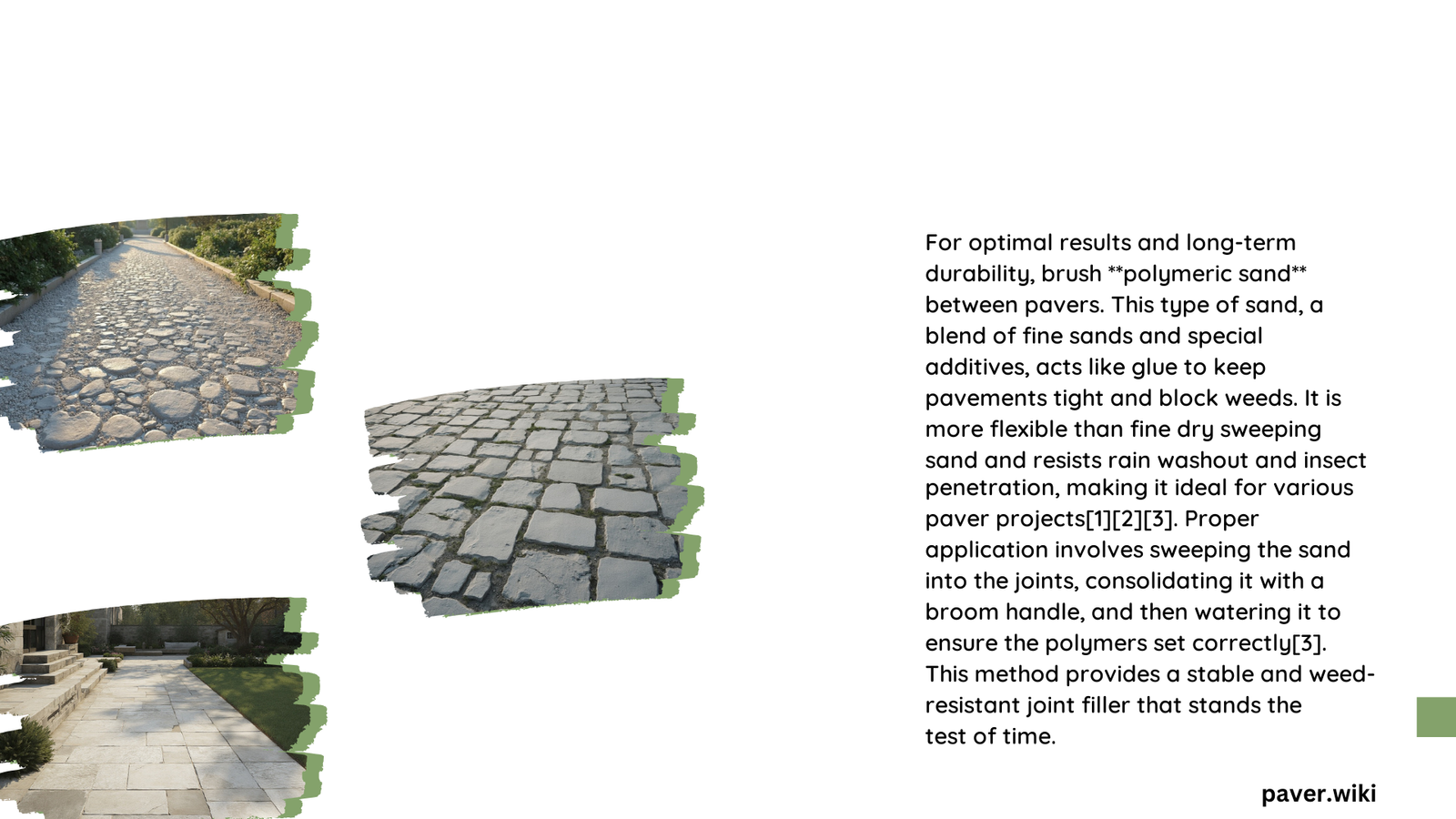When it comes to filling the joints between pavers, choosing the right material is crucial for durability, stability, and aesthetic appeal. This guide explores various options for brushing between pavers, including polymeric sand, fine dry sweeping sand, and mason sand. We’ll discuss their composition, application methods, and pros and cons to help you make an informed decision for your paver project.
What Are the Best Materials to Brush Between Pavers?
The most common materials used to fill paver joints are:
- Polymeric Sand
- Fine Dry Sweeping Sand
- Mason Sand
- Joint Compound
- Coarse Sand with Sealant
Each of these materials has its unique properties and benefits. Let’s explore them in detail.
Why Is Polymeric Sand Often Recommended for Paver Joints?

Polymeric sand is highly favored for paver joints due to its durability and effectiveness in preventing weed growth and insect infestations. Here’s what you need to know:
- Composition: A mix of fine sand grains and special additive particles that bond when exposed to water.
- Application Method:
- Clean paver joints thoroughly
- Spread sand evenly over pavers
- Sweep into joints using a broom
- Compact with a plate compactor or hand tamper
- Mist with water to activate polymers
-
Allow 24 hours for curing
-
Optimal Moisture: Damp but not soaked
- Curing Time: Typically 24 hours, weather-dependent
- Popular Brands: Techniseal, Dyna Optimatrix, Surebond Polysweep, Gator Supersand Bond
How Does Fine Dry Sweeping Sand Compare to Polymeric Sand?
Fine dry sweeping sand is easier to install but has some drawbacks:
- Composition: Especially fine sand, easy to sweep into joints
- Application:
- Sweep into joints with a broom
- Compact using a plate compactor or hand tamper
- Pros: Easy to install, inexpensive
- Cons: Can wash away over time, doesn’t prevent weeds or insects effectively
What Are the Benefits of Using Mason Sand for Paver Joints?
Mason sand is finer than concrete sand and offers some advantages:
- Composition: Finer than concrete sand, packs tightly into joints
- Application: Similar to fine dry sweeping sand
- Pros: Less likely to wash away than concrete sand
- Cons: Not as effective as polymeric sand in preventing weeds and insects
Are There Other Options for Filling Paver Joints?
Yes, there are alternative materials for specific situations:
Joint Compound
- Composition: Synthetic product applied wet, dries hard
- Best for: Larger joints
- Pros: Permeable, can be installed in any weather
- Cons: Not suitable for heavy vehicular traffic or joints less than 3/16\”
Coarse Sand with Sealant
- Composition: Coarse sand (e.g., pool filter sand) with liquid sealant
- Application:
- Fill joints with coarse sand
- Apply stabilizing paver sealer
- Pros: Provides light polish, ensures stability
- Cons: May not be as durable as polymeric sand in harsh weather
How Much Material Do I Need and What Are the Costs?
Here’s a breakdown of quantities and cost estimates:
| Material | Quantity (per 10 sq ft) | Cost Estimate (per sq ft) |
|---|---|---|
| Polymeric Sand | 1-2 lbs | $0.20 – $0.50 |
| Fine Dry Sweeping Sand | 1-2 lbs | $0.10 – $0.20 |
| Mason Sand | 1-2 lbs | $0.15 – $0.30 |
What Challenges Might I Face with Each Material?
Each material comes with its own set of challenges:
Polymeric Sand
- Requires proper moisture for curing
- Cannot be installed in rain
- More expensive than other options
Fine Dry Sweeping Sand
- Can wash away over time
- Doesn’t prevent weeds or insects effectively
- May need frequent refilling
Mason Sand
- Not as effective as polymeric sand for weed and insect prevention
- May wash away in heavy rain
How Do I Choose the Right Material for My Project?
Consider these factors when selecting what to brush between pavers:
- Climate: If you live in an area with heavy rainfall, polymeric sand or joint compound might be better options.
- Traffic: For high-traffic areas, polymeric sand or mason sand offer better stability.
- Aesthetics: Consider the color and texture that best complements your pavers.
- Maintenance: Polymeric sand requires less frequent refilling compared to other options.
- Budget: Weigh the initial cost against long-term maintenance expenses.
What Tools Do I Need to Brush Sand Between Pavers?
To properly brush sand between pavers, you’ll need:
- Push broom
- Plate compactor or hand tamper
- Garden hose with spray nozzle (for polymeric sand)
- Leaf blower (optional, for cleaning)
How Often Should I Refill the Joints Between Pavers?
The frequency of refilling depends on the material used:
- Polymeric Sand: Every 2-5 years, depending on weather conditions and traffic
- Fine Dry Sweeping Sand: Annually or bi-annually
- Mason Sand: Every 1-2 years
Regular inspection and maintenance will help determine when refilling is necessary.
By understanding what to brush between pavers and the properties of different joint filling materials, you can make an informed decision that ensures the longevity and beauty of your paver installation. Remember to consider factors such as climate, traffic, and maintenance requirements when choosing the best option for your specific project.
References:
1. What Kind of Sand is Best for My Pavers? | Keep It Clean
2. Fine Dry Sweeping Sand vs Polymeric Sand – Western Interlock
3. Why Choose Polymeric Sand For Paver Jointing? – Techniseal
